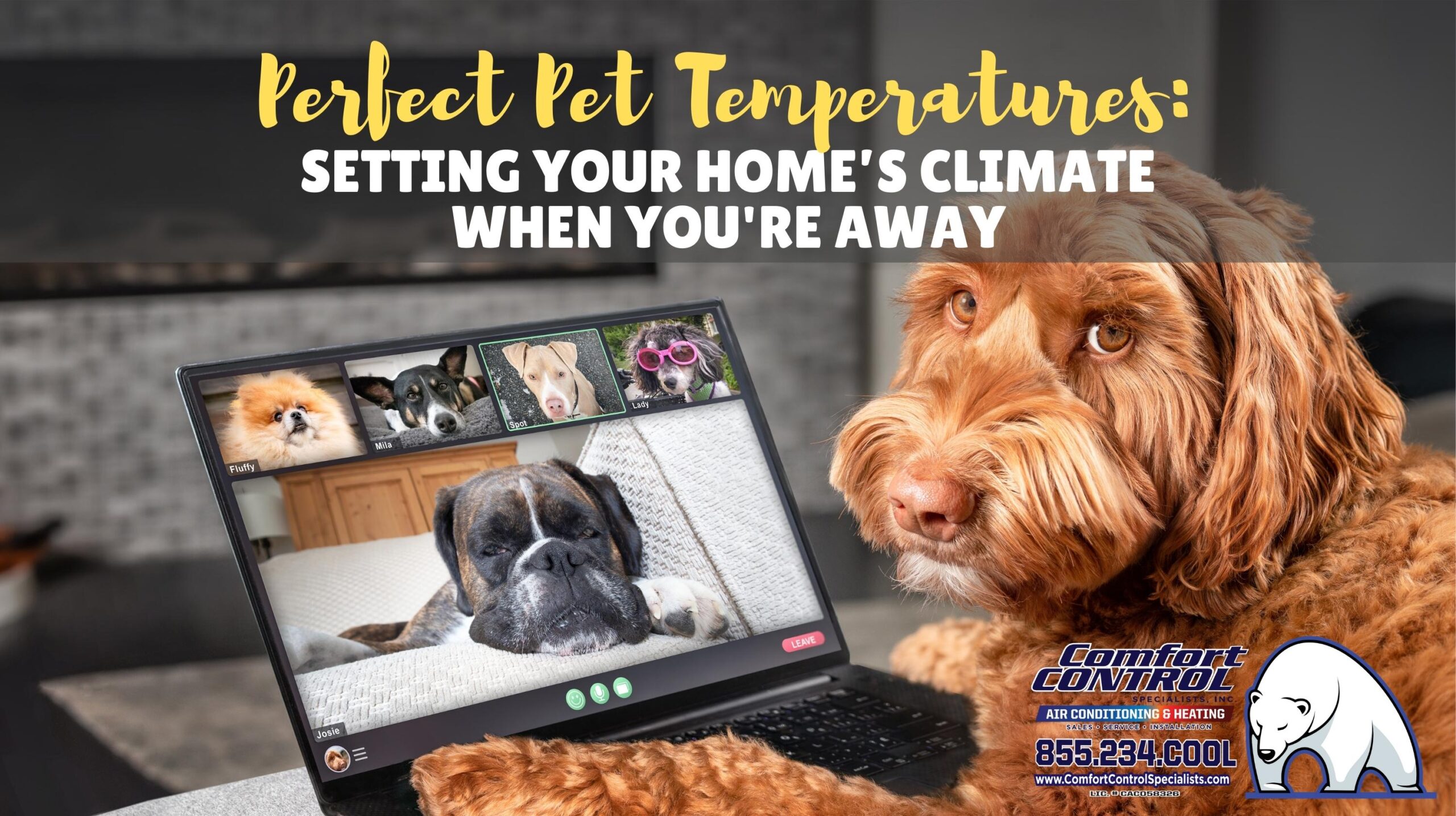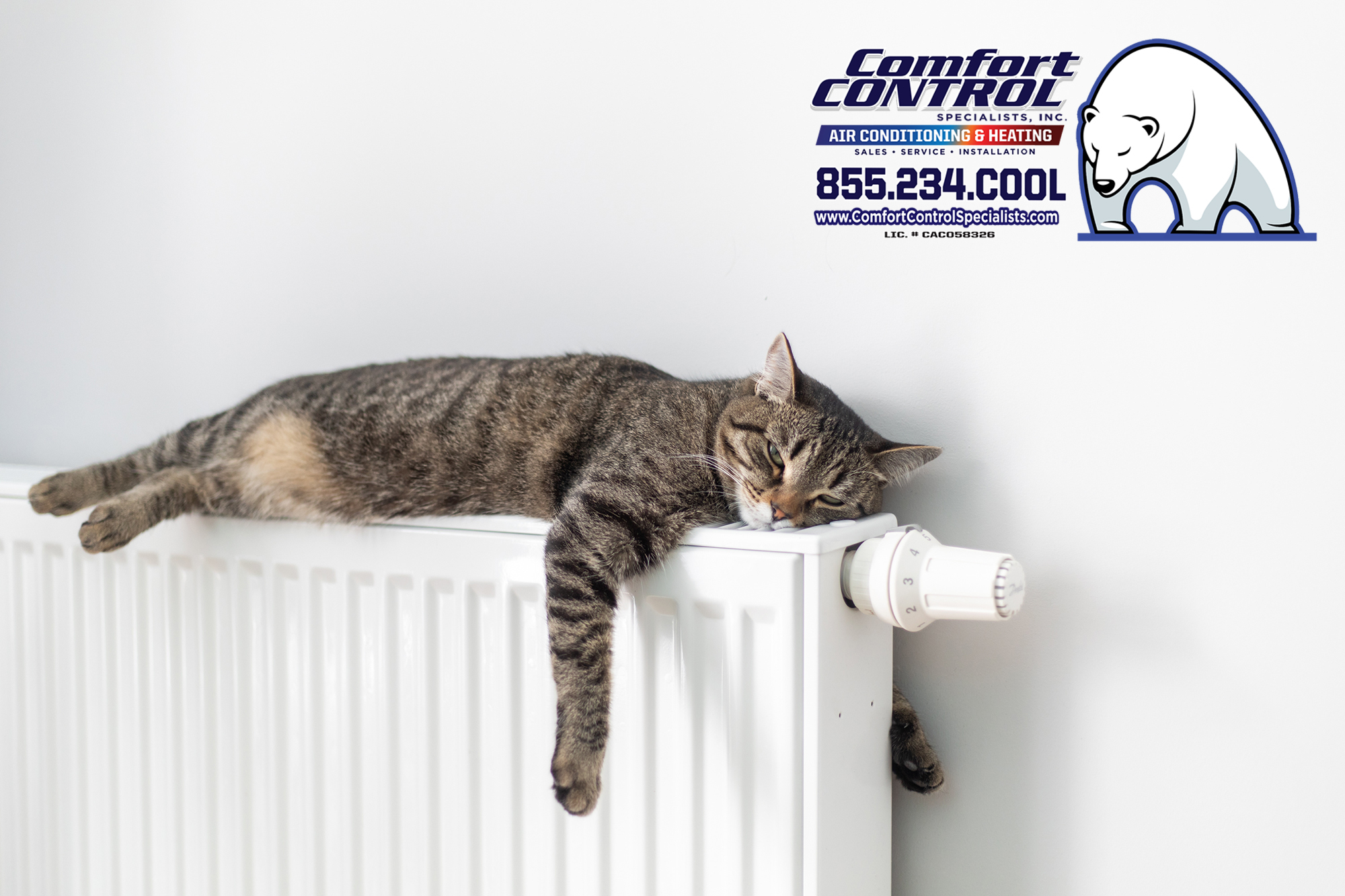[vc_row][vc_column][vc_column_text]Leaving your pets at home when you’re away is a common scenario. What isn’t so common is the knowledge of how to maintain the ideal temperature for different kinds of pets, to ensure their comfort and health. In this article, we’ll guide you through temperature requirements for various pets, giving you a better understanding of how to set your home’s temperature when you’re not around.
Understanding Your Pet’s Native Climate
Pets like cats, dogs, birds, reptiles, and small mammals all have unique body temperatures and thrive in specific temperature ranges that often reflect their native habitats. Understanding the climates these animals are naturally adapted to can offer valuable insights into what conditions they’ll find comfortable in your home.
Dogs and Cats: Temperate Climate Companions
Our most common pets, dogs and cats, come from varied ancestral backgrounds, ranging from the arctic chill of the Siberian Husky’s native land to the warm savannas where African wildcats, ancestors of domestic cats, evolved.
Yet, centuries of domestication have made them adaptable to a wide range of conditions. Most dogs and cats are comfortable in temperatures between 60°F and 80°F (15°C – 26.7°C), much like their human owners. Extreme temperatures outside of these ranges can lead to stress, discomfort, or even serious health issues like hypothermia or heatstroke.
Birds: Tropical and Temperate Flyers
Bird species like parakeets and cockatiels come from Australia’s warm climates, while canaries originate from the more temperate Canary Islands. The ideal home temperature for these birds is around 65°F – 80°F (18°C – 27°C).
Some bird species may tolerate slightly higher temperatures, but caution is needed to avoid overheating. Birds don’t sweat and can only cool down by panting or fluffing their feathers. Signs of overheating in birds include panting, wing spreading, and lethargy.
Reptiles: Heat-Loving Cold-Blooded Creatures
Reptiles, being cold-blooded, rely on external temperatures to regulate their body heat. A pet reptile’s ideal temperature can vary widely based on its species. For example, bearded dragons thrive in temperatures between 80°F – 85°F (26.7°C – 29.4°C) during the day, with basking spots reaching up to 100°F (37.8°C). On the other hand, the corn snake prefers temperatures between 70°F – 85°F (21.1°C – 29.4°C).
Small Mammals: Diverse Needs for Petite Pets
Small mammals such as hamsters, rabbits, and guinea pigs also have a wide range of temperature needs. Hamsters come from desert environments and can tolerate temperatures up to 80°F (26.7°C), while rabbits and guinea pigs prefer cooler conditions, ideally between 60°F – 70°F (15°C – 21.1°C).
How to Manage Your Home’s Temperature
Now that you understand your pet’s natural temperature preferences, how can you accommodate these needs in your home, especially when you’re away?
Smart Thermostats: Technology to the Rescue
Smart thermostats are an excellent tool to maintain consistent temperatures. They allow you to set daily schedules and make temperature adjustments remotely through a smartphone app. These devices can be programmed to keep your home within the preferred temperature range of your pets, adjusting as needed throughout the day.
Heating and Cooling Solutions for Reptiles
For reptile owners, maintaining a proper heat gradient is essential. This can be achieved with under-tank heaters, ceramic heat lamps, and even heat rocks that give reptiles a warm spot to bask. Don’t forget to provide a cooler area in the enclosure where your pet can retreat if it gets too hot.
When it comes to cooling, especially for pets in high-temperature areas, air conditioning systems, fans, and cool tiles can provide respite from the heat. However, be cautious as drafts or sudden temperature changes can be harmful to many reptile species.
Regular Monitoring
Regardless of the methods used, regular temperature checks are crucial. Simple digital thermometers or more advanced temperature and humidity gauges can be installed to provide constant readings. Some smart thermostats even have the capability to report home conditions directly to your smartphone, allowing you to monitor and adjust as necessary when you’re away.
Supplementing Your Pet’s Environment
Supplementing your pet’s environment with appropriate amenities can help maintain a comfortable temperature.
Providing Shade and Insulation
For dogs and cats, providing shaded areas and blankets can be a simple yet effective solution. A cozy cat bed or a dog crate covered with a blanket creates insulating pockets of warm air.
In contrast, during hot weather, shades, blinds, or thermal curtains can prevent indoor temperatures from rising due to sunlight. Some pet owners even use cooling mats that can provide a cool spot for pets during a hot day.
Access to Fresh Water
Pets will drink more water when it’s hot, and less when it’s cold. Make sure your pets have access to fresh water at all times. Consider investing in a pet water fountain which encourages drinking through continuous water movement.
Enclosure Management for Small Mammals
For small mammals, enclosure management can greatly influence their thermal comfort. Bedding can provide insulation and burrowing opportunities. Care should be taken to avoid placing their enclosures in direct sunlight, near drafts, or close to heating/cooling vents.
Conclusion
Each type of pet has unique temperature needs and tolerances. By understanding these requirements and adjusting your home’s climate accordingly, you can provide your pet with a comfortable and healthy environment even when you’re away. Smart thermostats, heating/cooling solutions, regular monitoring, and environmental supplementation all play a crucial role in achieving this goal.
Remember, the well-being of your pet is of utmost importance. If you notice any signs of your pet being too cold or too hot, like lethargy, panting, lack of appetite, or discomfort, it might be an indication that you need to adjust the temperature or consult a vet. Just like humans, our pets rely on us to make their living conditions as perfect as possible, and ensuring their environment’s temperature is just right is a major part of that responsibility.
Popular Pet Temperature Suggestions:
Here’s a list of popular pets along with the suggested temperature ranges for their comfort and safety when you’re away from home:
- Dogs: Domestic dogs are quite adaptable, but generally, they’re comfortable with temperatures between 60°F and 80°F (15°C – 26.7°C). Puppies, elderly dogs, or dogs with health conditions may require warmer conditions.
- Cats: Like dogs, domestic cats typically prefer temperatures between 60°F and 80°F (15°C – 26.7°C). However, it’s important to note that cats are good at finding warm spots when they’re cold and cool spots when they’re hot.
- Birds (e.g., parakeets, canaries, cockatiels): For these common bird species, a comfortable temperature range is between 65°F and 80°F (18°C – 27°C). They can tolerate slightly higher temperatures, but it’s crucial to watch for signs of overheating.
- Rabbits: Rabbits are most comfortable in temperatures between 60°F and 70°F (15°C – 21.1°C). They’re particularly sensitive to heat and should never be kept in high-temperature environments.
- Guinea Pigs: Guinea pigs prefer cooler conditions, similar to rabbits. Ideal temperatures for them range between 60°F and 70°F (15°C – 21.1°C).
- Hamsters: Hamsters can tolerate temperatures up to around 80°F (26.7°C), but should not be exposed to extreme heat. Their preferred temperature range is between 65°F and 75°F (18°C – 24°C).
- Reptiles (e.g., bearded dragons, corn snakes): Reptiles have a wide range of temperature requirements, depending on their species. Bearded dragons thrive in temperatures between 80°F – 85°F (26.7°C – 29.4°C) during the day, with basking spots reaching up to 100°F (37.8°C). Corn snakes prefer temperatures between 70°F – 85°F (21.1°C – 29.4°C).
- Fish: Depending on the species, fish can require a wide range of water temperatures. For instance, goldfish thrive in water temperatures between 65°F – 75°F (18°C – 24°C), while tropical fish species such as bettas and guppies prefer warmer temperatures, generally between 74°F – 82°F (23°C – 28°C).
Please note that these are general guidelines and individual pets may have specific needs. Always monitor your pet for signs of discomfort and consult a vet if needed. If your home’s temperature cannot be maintained within these ranges when you’re away, consider using a pet sitter or a pet daycare service.
If you live in Odessa, Keystone, Spring Hill, Tarpon Springs, Land O Lakes, Oldsmar, Brooksville, or the surrounding areas, please don’t hesitate to contact the Comfort Control Specialists for a comprehensive AC inspection and tune-up or AC repair.[/vc_column_text][/vc_column][/vc_row]




